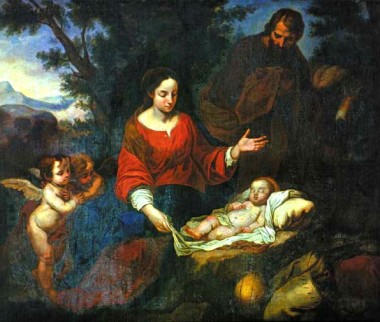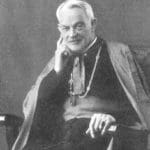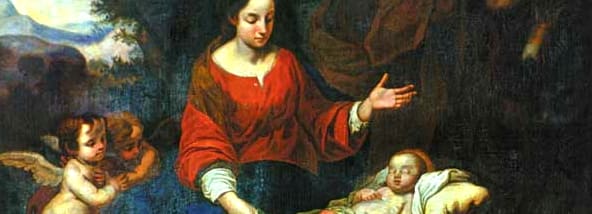THE NATIVITY: Part I of II
“And it came to pass that in those days there went out a decree from Caesar Augustus, that the whole world should be enrolled. This enrolling was first done by Cyrenius, the governor of Syria. And all went to be enrolled, every one into his own city. And Joseph also went up from Galilee out of the city of Nazareth into Judea, to the city of David, which is called Bethlehem, because he was of the house and family of David, to be enrolled with Mary his espoused wife, who was with child. And it came to pass that when they were there her days were accomplished that she should be delivered. And she brought forth her first-born Son, and wrapped Him up in swaddling-clothes, and laid Him in a manger, because there was no room for them in the inn.” Luke 2:1-7
1. It is characteristic of the Gospels that the greatest events are told in the fewest words and with the utmost simplicity. The institution of the Blessed Sacrament, the Crucifixion, the power of absolution, are all told in a sentence; and the story of the birth of our Lord is no  exception to the rule. Indeed, but for St. Luke we might not have heard of it at all. But perhaps we have enough. To begin with we know that “there was no room for them in the inn.” Nor, apparently, was there much room for them in all Bethlehem. Nor later was there room for them in all Palestine. Nor, later still, does there seem to be much room for Him in all the world. Nor today is there much room for Him in the lives and hearts of most men. But I must not blame others; is there much room for Him in mine?
exception to the rule. Indeed, but for St. Luke we might not have heard of it at all. But perhaps we have enough. To begin with we know that “there was no room for them in the inn.” Nor, apparently, was there much room for them in all Bethlehem. Nor later was there room for them in all Palestine. Nor, later still, does there seem to be much room for Him in all the world. Nor today is there much room for Him in the lives and hearts of most men. But I must not blame others; is there much room for Him in mine?
2. Still a shelter of some kind was found, though it is to be noticed that St. Luke does not mention it. If we had no more than his description to go upon, we should almost be compelled to conclude that our Lord was born in the gutter by the roadside; literally the birth of a pauper and an outcast. The mention of the manger leads us to conclude that there was a shelter of some sort overhead; but not all mangers are indoors, especially in the East. Still let us accept the firm tradition, for the sake of our pitiful human nature if for nothing else; when our King first came into this world, at least He was given a stable cave in which He could be born, at least He was treated as well as our cattle, if not as well as ourselves.
3. And now that He is born, and lies helpless and apparently unnoticing before us like any other infant, let us kneel beside Him, with Mary, and Joseph, and the maid, and the countless saints who from that time till today have found in the mere sight of this Child enough to satisfy all their strongest cravings. Let us watch Him and His first adorers, in company with St. Gertrude, and St. Bridget, and St. Theresa. Let us take Him into our arms and nurse Him, as St. Bonaventure recommends us, and as St. Anthony of Padua was privileged to do, and St. Stanislaus Kostka, and so many more saints of weary life and labour. Let us give Him back to Our Lady, and learn from her a lesson on the way her Child should be treated. Let us hear the words ringing round the room, for our own greater consolation: “As many as received Him, to them he gave power to become the sons of God, to them that believe in His name.” “Brethren,” comments St. John on his own words, “you are now sons of God, but you know not what you shall be.”
Summary Mediation Points:
1. “There was no room for Him in the inn.” Nor has there been much room for Him anywhere in this world.
2. “He was laid in a manger.” At least this much was given Him; and it is enough to satisfy Him.
3. It is much for us to be able to unite ourselves with His first adorers.
 Editor’s Note: This meditation is from Archbishop Alban Goodier’s “The Prince of Peace” (1913).
Editor’s Note: This meditation is from Archbishop Alban Goodier’s “The Prince of Peace” (1913).
Art: ÐараджÑнне ХрыÑтова. ХІХ ÑÑ‚. ГродзенÑÐºÐ°Ñ Ð²Ð¾Ð±Ð» [Naradžènne Hrystova. Of the 19th century. Grodzenskaâ vobl], Author unknown, 19th century, PD, Wikimedia Commons. Mirror of Archbishop Alban Goodier, S.J., www.stmaryscadoganstreet.co.uk, all rights reserved, used with permission.
Â




